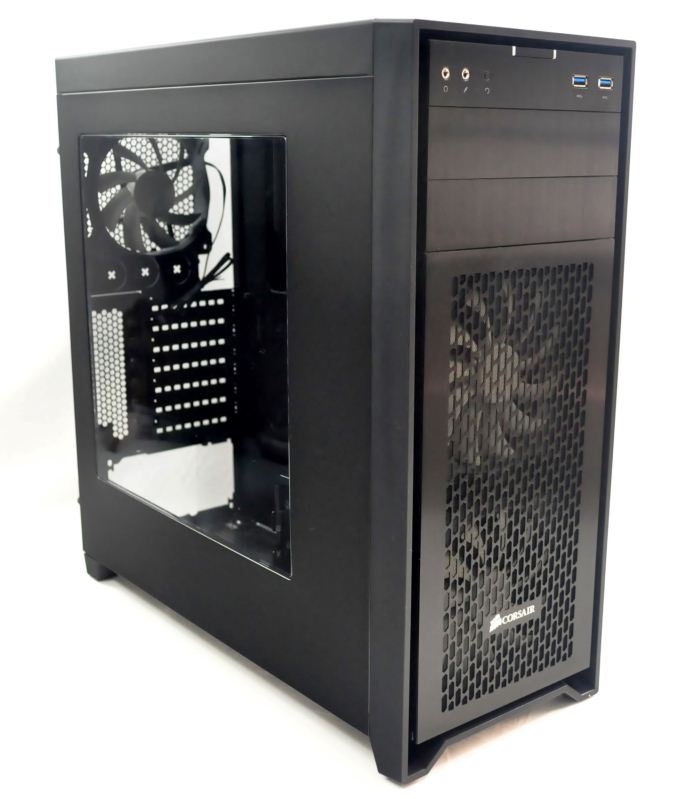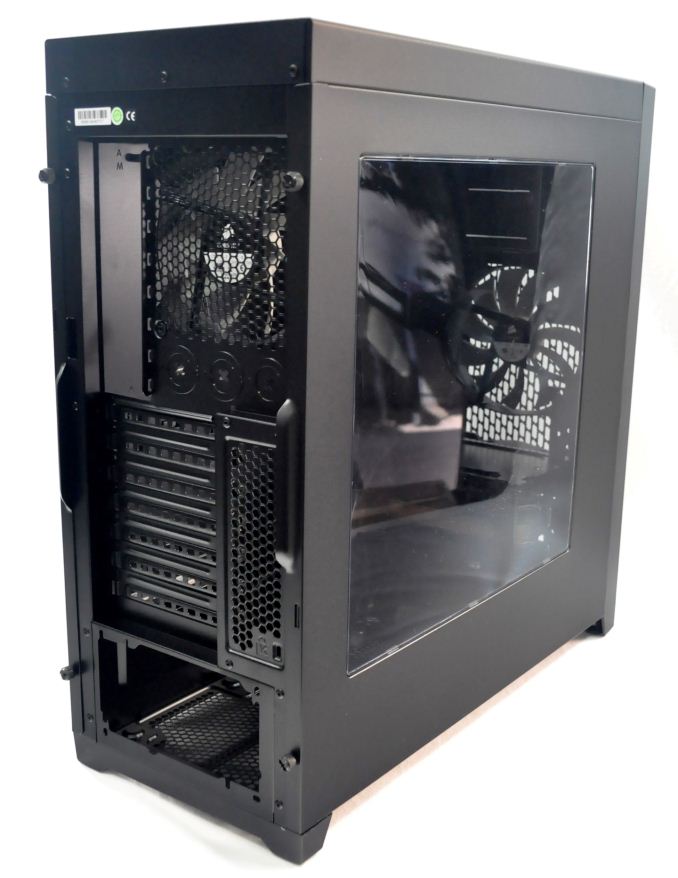Corsair Obsidian 450D Case Review
by E. Fylladitakis on April 4, 2014 6:00 AM EST- Posted in
- Cases/Cooling/PSUs
- Corsair
- mid-tower
- Case
Corsair Obsidian 450D Exterior
As mentioned on the previous page, the Obsidian 450D is a bridge between the smaller 350D and the larger 750D. It shares the same exact aesthetic design as the rest of the series, a post-minimalistic approach with clean lines, sharp angles, and basic geometric shapes. In fact, if not for the perforated front intake panel, the Obsidian 450D could be easily mistaken for a 350D or a 750D instead. The chassis of the case is made out of 1mm thick SECC steel and the front panel is made out of 2mm plastic. The front panel also forms the two front feet of the Obsidian 450D, while the rear plastic feet are each attached to the metallic chassis.
Two USB 3.0 ports and two 3.5" audio jacks (headphones, microphone) can be found near the top of the faceplate, right above the two 5.25" bays of the case. The power on button has a rectangular shape and is placed at the middle top part of the faceplate, between the power on and HDD activity LED lights. The reset button is much smaller and round, aligning in shape and size with the audio jacks.
The rest of the fascia is a removable, washable air intake filter. It can be removed very easily, by simply applying a little pressure at the top two corners simultaneously. Actually, it is so easy and simple to remove that it would probably be a bad idea to leave the Obsidian 450D in the vicinity of unattended children, especially as the removal of the filter reveals two unguarded 140mm intake fans.
The Obsidian 450D has plenty of ventilation and also plenty of filters installed. Aside from the front filter, there are large filters covering the bottom and the top panels of the case. The bottom panel is almost entirely perforated and a single magnetic filter covers it from one side to the other. It can be removed by simply pulling it off and reattached just as easily; with a little practice and if you have thin fingers, it is possible to remove/reattach the filter without having to roll the case on its side, as the feet of the Obsidian 450D are rather tall. Another similar magnetic filter covers the top panel as well, which actually is little more than a flexible magnetic frame with a dense mesh glued on it, but it matches the theme of the case perfectly and can be removed-cleaned-reattached within seconds.
Although the right side panel of the Obsidian 450D is entirely plain and uninteresting, the left side panel is one of its most prominent features. An acrylic window covers most of the left side panel, exposing much of the interior, including part of the PSU compartment. Due to the window, the left side panel cannot assist with the cooling of the case. Corsair, obviously in an effort to maximize ventilation and offset what little loss the solid side panels could impose, perforated what they could at the rear side of the case, including the expansion slot covers. It is interesting to note that there are three round holes for liquid cooling hoses and or cables; however there are no rubber grommets, only solid metal covers that can be permanently punched out. We realize that the percentage of users that will actually use an external liquid cooling kit with the Obsidian 450D is low but the installation of three rubber grommets shouldn't be much of an issue for a $120 case.


















36 Comments
View All Comments
ekagori - Sunday, April 6, 2014 - link
I personally like the way E has been reviewing his cases, using stock cooling in a case and components gives you a good idea how well a system will handle such constant loads at its most basic cooling levels. People complain about variance in components, well guess what, if a case can handle 850W of constant heat with stock cooling, it can handle a system with a 4930k, R9 290x, 3 HDDs that produces 550W. Oh but you wish to add another R9 290x for CF and now produces 800W? Well guess what, it can still handle it. Oh but what if I add a Noctua NH-D14 cooler to my rig...Hmmm... it will still handle it... What about if I add a few extra fans....Hmmm...yeah still good.The point of the review is for us to know if a system can handle a "normal" 450W load or an "extreme" 850W load on stock cooling regardless of what components you are using. Of course temperatures will be lower if you use better fans, better cpu cooler, water cooling for gpus, etc. But they will never be any higher or worse than at stock.
If people have such a problem with this methodology and want to have "useful" reviews based on individual components they may want to purchase than you should start spending countless of your hours to make your own reviews, let's see how far you get before you decide that reviewing thousands of different combinations is just plain useless and way too time consuming.
Sushisamurai - Monday, April 7, 2014 - link
^ this. The current methodology is better than the previous method due to the standardized input of heat. It eliminates most variables due to component differences.Additional comparisons between stock and added/differing components would be rendered pointless, as the stock would be a reference point and the components would therefore be akin to a margin of error. The problem lies in the variability of different setups/components giving far too many margin's of error. Which one would you use?
Say @stock @current methodology Case X dissipates @42 degrees @850W.
Components A test Case X @44 degrees @850W
Components A test change front fan B Case X @46 degrees @850W
Components A test change back fan B Case X @41 degrees @850W
Now what happens when you start mixing top/front/back fans and components? You're essentially testing components in a set Case, with new data points that are not comparable to other reviews. Or, you're essentially testing components to build the best setup in terms of heat-noise-temperature for that set case (common, Anandtech can't do all the work for you)
Hrel - Friday, April 11, 2014 - link
This case gets no quieter than 32db? That's absurdly loud.JimmyJame - Thursday, October 16, 2014 - link
Extremely disappointed in this product yes it might only be a small part however I have paid top dollar for this product. Opened up the box unpacked everything then come to find that the plastic foot at the back of the case has been broken. Plastic crap!phorgan1 - Saturday, February 6, 2016 - link
Corsair's web site says it supports eATX but you don't list that. Since I'm looking at a GIGABYTE GA-Z170X-SOC FORCE which is an eATX board, it sure would be nice to have confirmation.SCyn - Tuesday, January 16, 2018 - link
How do i undervolt the fans? help